1997 BUICK REGAL display
[x] Cancel search: displayPage 95 of 422
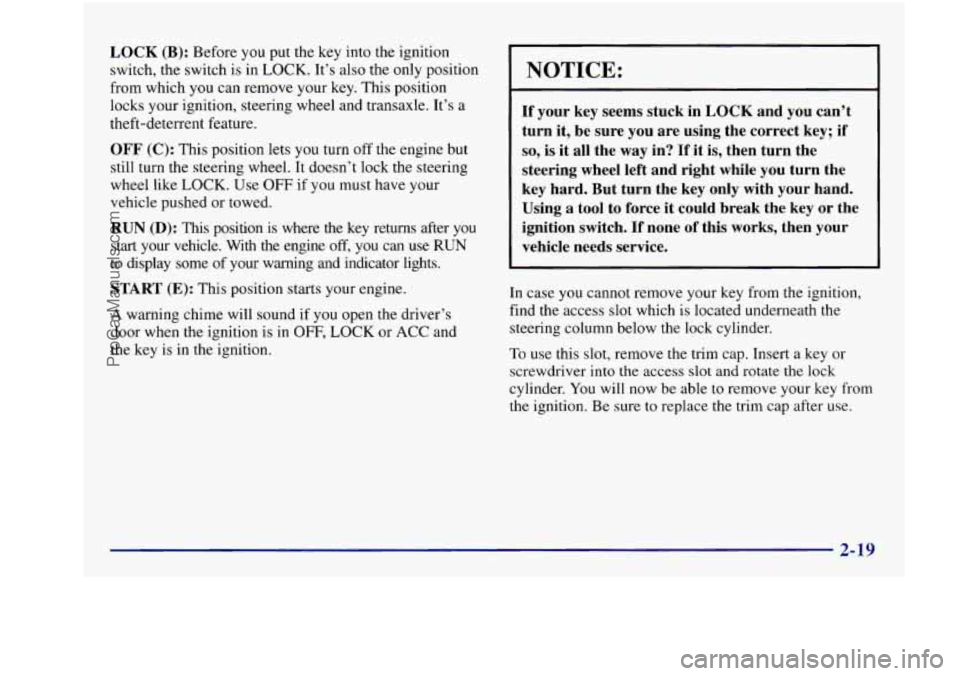
LOCK (B): Before you put the key into the ignition
switch, the switch is in LOCK. It’s also the only position
from which you can remove your key. This position
locks your ignition, steering wheel and transaxle. It’s a
theft-deterrent feature.
OFF (C): This position lets you turn off the engine but
still turn the steering wheel. It doesn’t lock the steering
wheel like LOCK. Use
OFF if you must have your
vehicle pushed or towed.
RUN (D): This position is where the key returns after you
start your vehicle. With the engine off, you can use RUN
to display some of your warning and indicator lights.
START (E): This position starts your engine.
A warning chime will sound if
you open the driver’s
door when the ignition is in
OFF, LOCK or ACC and
the key is in the ignition.
NOTICE:
If your key seems stuck in LOCK and you can’t
turn it, be sure
you are using the correct key; if
so, is it all the way in? If it is, then turn the
steering wheel left and right while you turn the
key hard. But turn the key only with your hand.
Using a tool to force it could break the key or the
ignition switch.
If none of this works, then your
vehicle needs service.
In case you cannot remove your key from the ignition,
find the access
slot which is located underneath the
steering column below the lock cylinder.
To use this slot, remove the trim cap. Insert a key or
screwdriver
into the access slot and rotate the lock
cylinder. You will now be able to remove your key
from
the ignition. Be sure to replace the trim cap after use.
ProCarManuals.com
Page 99 of 422
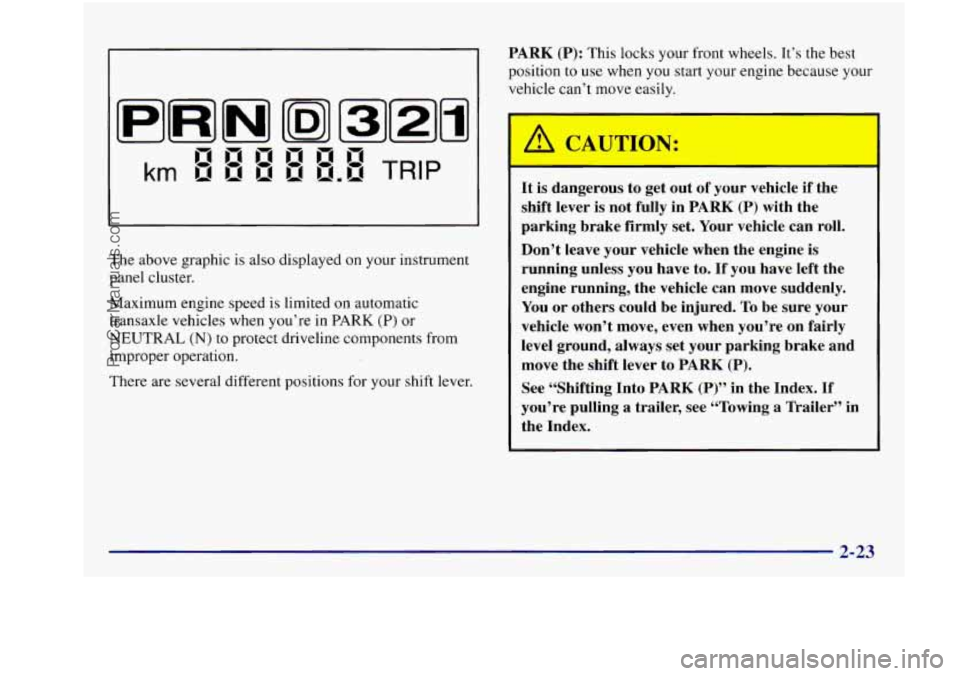
I I PARK (P): This locks your front wheels. It’s the best
I position to use when you start your engine because your
I I vehicle can’t move easilv.
-:
d
B I B I B!I BJ LI ------
km Irr Irr ,,r u ,,r,,,r TRIP
It is dangerous to get out of your vehicle if the
‘I
shift lever is not fully in PARK (P) with the
parking brake firmly set. Your vehicle can roll.
The above graphic is also displayed on your instrument
panel cluster.
Maximum engine speed
is limited on automatic
transaxle vehicles when you’re in PARK (P) or
NEUTRAL
(N) to protect driveline components from
improper operation.
There are several different positions for your shift lever.
Don’t leave your vehicle when the engine is
running unless you have to.
If you have left the
engine running, the vehicle can move suddenly.
You or others could be injured.
To be sure your
vehicle won’t move, even when you’re on fairly
level ground, always set your parking brake and
move the shift
lever to PARK (P).
See “Shifting Into PARK (P)” in the Index. If
you’re pulling a trailer, see “Towing a Trailer’’ in
the Index.
2-23
ProCarManuals.com
Page 134 of 422
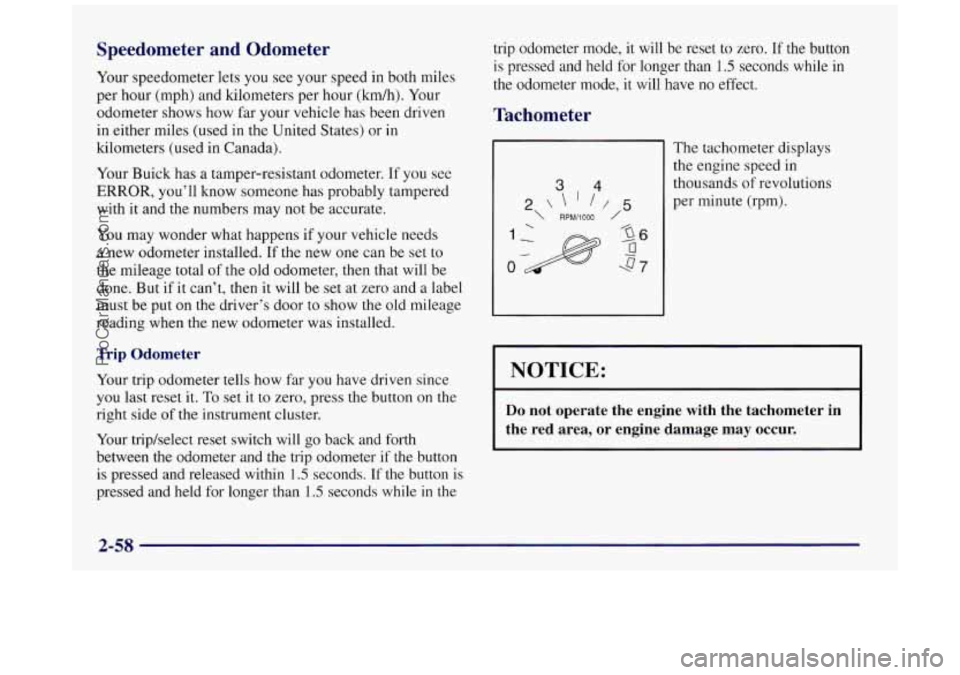
Speedometer and Odometer
Your speedometer lets you see your speed in both miles
per hour (mph) and kilometers per hour (km/h). Your
odometer shows how far your vehicle has been driven
in either miles (used
in the United States) or in
kilometers (used in Canada).
Your Buick has a tamper-resistant odometer. If you see
ERROR, you’ll know someone has probably tampered
with it and the numbers may not be accurate.
You may wonder what happens if your vehicle needs
a new odometer installed. If the new one can be set to
the mileage total of the old odometer, then that will be
done. But if it can’t, then it will be set at zero and
a label
must be put
on the driver’s door to show the old mileage
reading when the new odometer was installed.
Trip Odometer
Your trip odometer tells how far you have driven since
you last reset it.
To set it to zero, press the button on the
right side
of the instrument cluster.
Your triphelect reset switch will
go back and forth
between the odometer and the trip odometer if the button
is pressed and released within 1.5 seconds. If the button is
pressed and held for longer than
1.5 seconds while in the trip
odometer mode, it will be reset to zero. If the button
is pressed and held for longer than 1.5 seconds while in
the odometer mode, it will have no effect.
Tachometer
1
0
5 /
The tachometer displays
the engine speed
in
thousands of revolutions
per minute (rpm).
NOTICE:
Do not operate the engine with the tachometer in
the red area, or engine damage may occur.
2-58
ProCarManuals.com
Page 149 of 422
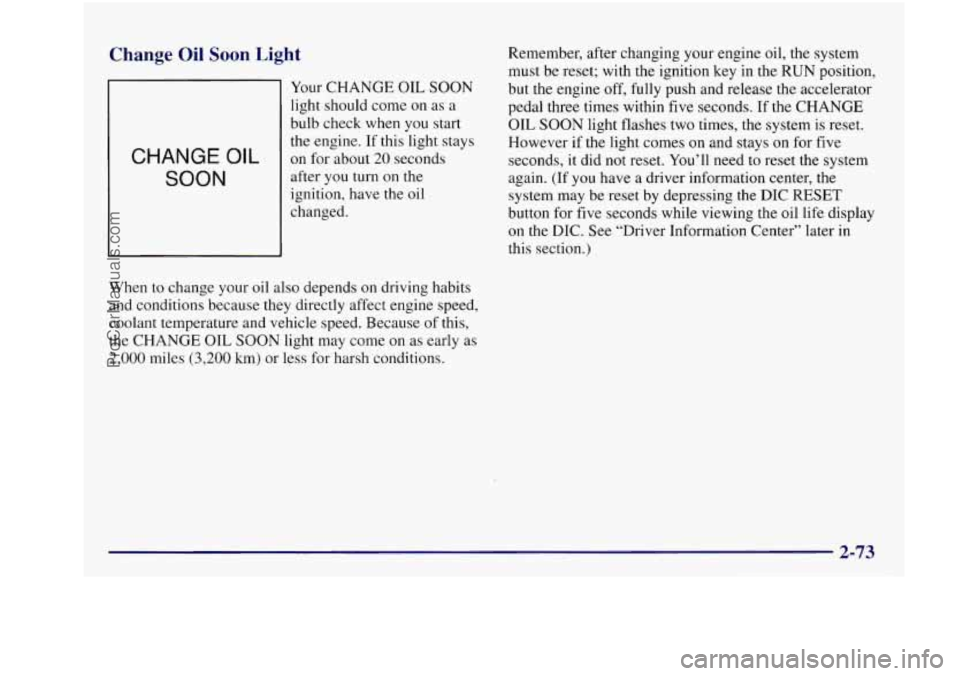
Change Oil Soon Light
CHANGE OIL
SOON
Your CHANGE OIL SOON
light should come on as a
bulb check when you start
the engine. If this light stays
on for about 20 seconds
afte.r you turn
on the
ignition, have the oil
changed.
When to change your oil also depends
on driving habits
and conditions because they directly affect engine speed,
coolant temperature and vehicle speed. Because
of this,
the CHANGE OIL SOON light may come on as early as
2,000 miles (3,200 km) or less for harsh conditions. Remember,
after changing your engine
oil, the system
must be reset; with the ignition key in the
RUN position,
but the engine off,
fully push and release the accelerator
pedal three times within five seconds.
If the CHANGE
OIL SOON light flashes two times, the system is reset.
However if the light comes on and stays on for five
seconds, it did not reset. You’ll need to reset the system
again. (If you have a driver information center, the
system may be reset
by depressing the DIC RESET
button for five seconds while viewing the oil life display
on the DIC. See “Driver Information Center” later in
this section.)
ProCarManuals.com
Page 154 of 422
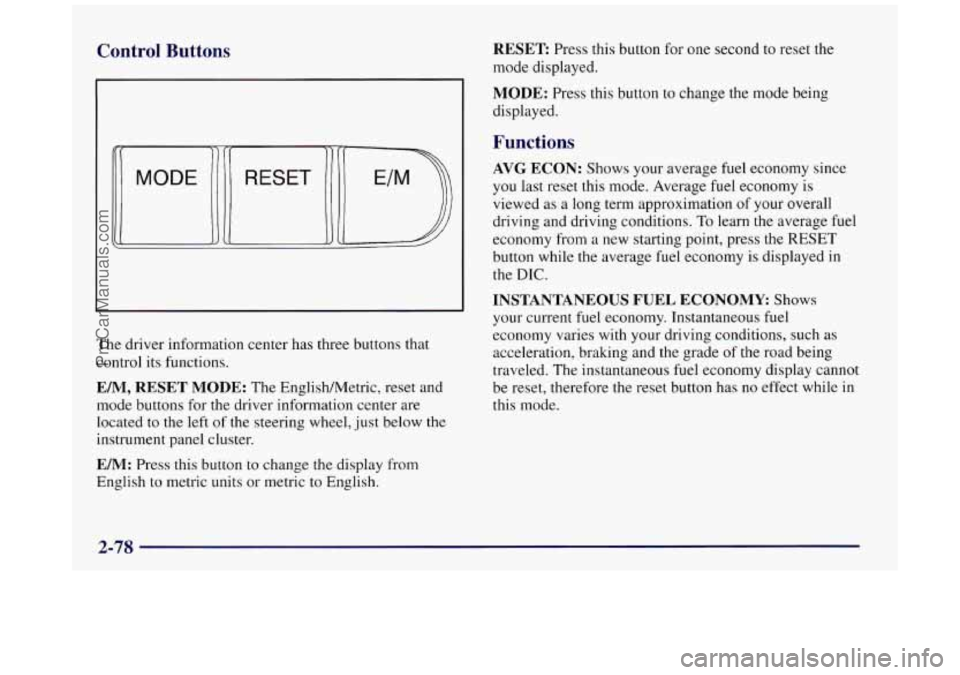
Control Buttons
The driver information center has three buttons that
control its functions.
EM, RESET MODE: The EnglishMetric, reset and
mode buttons for
the driver information center are
located to the left
of the steering wheel, just below the
instrument panel cluster.
EM: Press this button to change the display from
English to metric units or metric
to English.
RESET Press this button for one second to reset the
mode displayed.
MODE: Press this button to change the mode being
displayed.
Functions
AVG ECON: Shows your average fuel economy since
you last reset this mode. Average fuel economy is
viewed
as a long term approximation of your overall
driving and driving conditions.
To learn the average fuel
economy from a new starting point, press the RESET
button while the average fuel economy is displayed
in
the DIC.
INSTANTANEOUS FUEL ECONOMY Shows
your current
fuel economy. Instantaneous fuel
economy varies with your driving conditions, such
as
acceleration, braking and the grade of the road being
traveled.
The instantaneous fuel economy display cannot
be reset, therefore the reset button has no effect while in
this mode.
2-78
ProCarManuals.com
Page 155 of 422
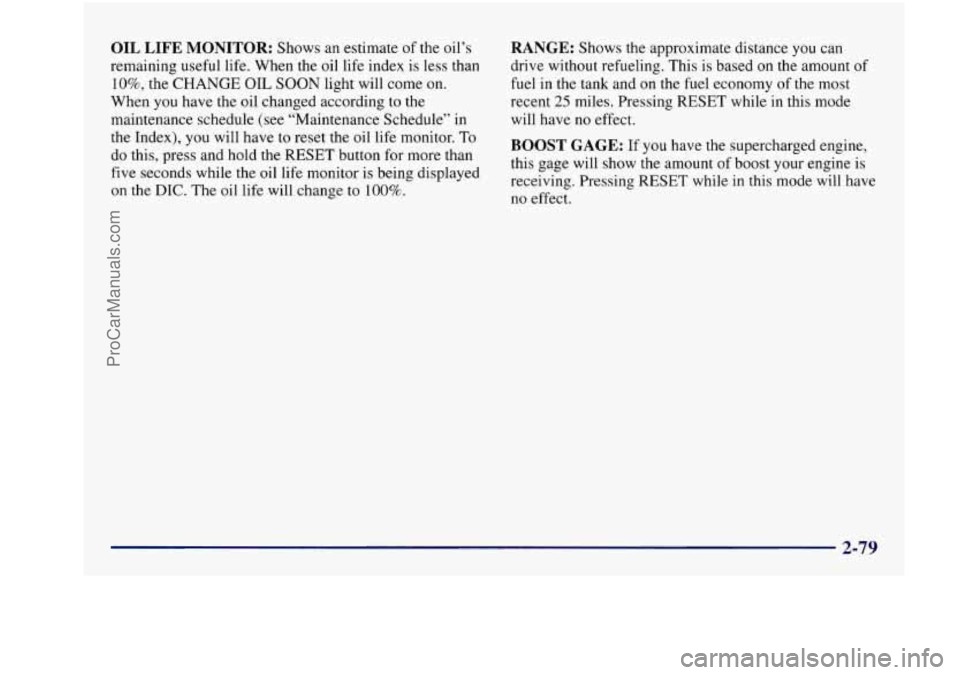
OIL LIFE MONITOR: Shows an estimate of the oil’s RANGE: Shows the approximate distance you can
remaining useful life. When the oil life index is less than drive without refueling. This is based on the amount
of
lo%, the CHANGE OIL SOON light will come on. fuel in the
tank and on the fuel economy of the most
When you have the oil changed according to the recent 25 miles. Pressing
RESET while in this mode
maintenance schedule (see “Maintenance Schedule” in will have
no effect.
the Index),
YOU will have to reset the oil life monitor. TO BOOST GAGE: If you have the supercharged engine,
five seconds while the oil life monitor is being displayed receiving. Pressing RESET while in this mode will have
on the DIC. The
oil life will change to 100%.
do this, press and hold the RESET button for than this gage will show the amount of boost your engine is
no effect.
ProCarManuals.com
Page 163 of 422

Dual Automatic ComforTemp Climate Control
(If Equipped)
FRONT
With this system, you set a temperature. You can then
either let the system automatically control airflow
direction and force
it to maintain the temperature, or you
can manually adjust it.
The system works best if you
keep your windows closed while using it.
Automatic Control
For
the most efficient operation, you should set the
system temperature and press AUTO. The system will
select the best fan speed and airflow settings to keep you
comfortable. The air conditioning compressor will run if
the outside temperature is above
40°F (4°C). You may
notice a delay of two to three minutes before the fan
comes on at start up in cool weather.
Driver's Temperature Control
The TEMP switch sets the temperature for the entire
system when the light on the DUAL button isn't lit. If
the light
is lit, this control sets the temperature for the
driver only. Press the up arrow to raise the temperature
and press the down arrow to lower the temperature. The
display will show your selection for a few seconds, then
the outside temperature will show. If
you push the
AUTO button, the system will control the fan speed
and airflow.
ProCarManuals.com
Page 164 of 422

Passenger’s Temperature Control
The PASSENGER CONTROL buttons with the arrows
adjust the temperature
on the passenger’s side so it is
warmer or cooler than the temperature set by the driver.
Push the
DUAL button so the indicator light on it is lil.
Press the right arrow button to raise the temperature.
Press the left arrow button to lower the temperature. The
display
will not show the passenger’s side temperature,
only that
of the driver. Tndicators in the passenger
control section will show passenger temperature relative
to the driver’s set temperature.
0 The amber light indicates the same temperature as
set for the driver.
The red lights indicate a warmer temperature than
that of the driver.
The blue lights indicate a cooler temDerature than
that of the driver.
Manual Control
If you prefer to manually control the heating, cooling
and ventilation in your vehicle, you can select airflow
direction,
fan speed, outside or recirculated air and air
compressor operation with the following buttons:
AIR FLOW: This control has several settings to
control the direction
of airflow when the system is not
in AUTO.
To access the various modes available, continue to press
the following four
ATR FLOW up and down arrows
until the desired mode appears in the display:
0
0
0
WINDSHIELD/FLOOR: This setting directs half
of the air to the floor ducts and half to the defroster
and side window vents.
MID/FLOOR: This setting directs half of the air
through the instrument panel outlets. Most
of the
remaining air is directed through the floor ducts and
a little to the defroster and side window vents.
MID: This setting directs air through
the instrument
panel outlets.
ProCarManuals.com